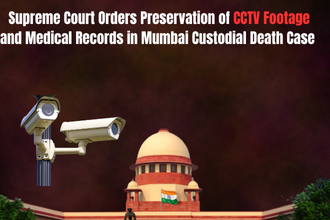Introduction
In a significant step toward ensuring accountability in custodial deaths, the Supreme Court of India has directed the State of Maharashtra to preserve CCTV footage and medical records in the case of an alleged custodial torture and death of a 19-year-old boy lodged at Mumbai Central Prison (Arthur Road Jail). The Court’s order comes in response to a Special Leave Petition (SLP) filed by the deceased’s mother, Jaitunbi Mohammad Salim Shaikh, challenging the Bombay High Court’s refusal to grant interim relief for preservation of crucial evidence.
This direction underscores the Court’s ongoing commitment to upholding Article 21 of the Constitution—the right to life and personal liberty—and strengthens the judicial stance against the culture of impunity surrounding custodial violence in India.
Background of the Case
According to the SLP, the deceased was arrested on September 16, 2025, and at the time of arrest, he had no visible injuries. However, on September 24, just eight days later, he was found dead in custody. His mother alleges that the police and prison authorities not only suppressed his hospitalization details but also fabricated reasons for his transfer to the hospital.
The petitioner approached the Bombay High Court, seeking:
- An independent investigation into the custodial death,
- Registration of an FIR, and
- Immediate preservation of CCTV footage and medical documents from Arthur Road Prison and the Kala Chowki Police Station between September 16 and 24.
While the High Court issued notice on the writ petition, it denied interim relief for preservation of the evidence. This denial prompted the petitioner to approach the Supreme Court through a Special Leave Petition, emphasizing the imminent risk of tampering or destruction of critical evidence.
Supreme Court’s Directions
The Supreme Court Bench comprising Justice M.M. Sundresh and Justice Vipul M. Pancholi, after hearing the matter on October 13, 2025, issued notice to the State of Maharashtra and directed that:
- The CCTV footage from the Arthur Road Prison and Kala Chowki Police Station for the period between September 16–24 be preserved immediately.
- All medical documents, hospital records, and post-mortem reports related to the deceased be secured and protected until further orders.
The Court emphasized that these materials constitute vital evidence in determining the truth behind custodial death allegations and ensuring justice for the victim’s family.
Connection with Supreme Court’s Suo Motu Case on Custodial Deaths
This order aligns with the Supreme Court’s earlier suo motu cognisance taken over a report published by Dainik Bhaskar, which revealed that 11 people had died in police custody in just seven to eight months across India. The apex court, in that matter, stressed the importance of preserving CCTV footage, station diary entries, and medical records in all cases of alleged custodial deaths.
The present case, therefore, draws strength from that suo motu proceeding, where the Court reaffirmed that transparency and accountability in police stations and prisons are essential components of constitutional governance and the rule of law.
Significance of CCTV Preservation in Custodial Death Investigations
The directive to preserve CCTV footage is not merely procedural—it lies at the heart of evidence preservation in custodial death cases. In many past instances, courts have lamented the *non-availability or tampering of CCTV recordings, which often results in *acquittal of accused officers or failure of justice.
Relevant Precedents:
- Paramvir Singh Saini v. Baljit Singh (2020) 13 SCC 703 – The Supreme Court mandated the installation of CCTV cameras with audio recording facilities in all police stations and investigative agencies to ensure transparency.
- D.K. Basu v. State of West Bengal (1997) 1 SCC 416 – Laid down detailed guidelines on arrest, detention, and custodial safeguards, which have since become the cornerstone of custodial rights jurisprudence.
- Re: Death of 23-year-old in Judicial Custody (2023 Suo Motu Case) – The Court reiterated that CCTV recordings are a “silent witness” to the truth in custodial settings.
By invoking these principles, the present order reinforces the judiciary’s insistence on non-negotiable preservation of electronic and medical evidence in custodial settings.
Custodial Deaths: A Persistent Challenge
Despite judicial vigilance, custodial violence continues to plague India’s criminal justice system. According to the National Human Rights Commission (NHRC) data, hundreds of custodial deaths are reported annually, though only a fraction result in convictions.
Many of these deaths occur under mysterious circumstances, with official explanations ranging from “suicide” to “illness.” However, patterns of injury, delayed medical attention, and fabricated records often point toward torture or abuse.
The Mumbai custodial death case stands as yet another grim reminder of systemic failures in ensuring detainee rights, particularly for underprivileged youth who lack legal representation or visibility.
Legal and Constitutional Implications
The Supreme Court’s intervention reflects its broader constitutional mandate under:
- Article 21 – Protection of life and personal liberty,
- Article 22 – Safeguards against arbitrary arrest and detention, and
- Article 32 – Right to constitutional remedies.
Moreover, the Code of Criminal Procedure (CrPC) and the newly enacted Bharatiya Nagarik Suraksha Sanhita (BNSS) continue to emphasize accountability of law enforcement officers during arrest and custody. The Court’s order is therefore a preemptive step to secure material evidence, which can be pivotal in establishing criminal liability if custodial torture is proven.
Role of Independent Investigation
The petitioner’s plea also calls for an independent probe, preferably by an agency outside the State police apparatus, citing a conflict of interest. This echoes the Supreme Court’s earlier observation in People’s Union for Civil Liberties v. State of Maharashtra (2014) 10 SCC 635, where it directed that deaths in police encounters or custody must be investigated by an independent agency to ensure impartiality.
An unbiased investigation, supported by preserved digital and medical evidence, is essential to rebuild public trust and uphold the credibility of the criminal justice system.
Conclusion
The Supreme Court’s order in Jaitunbi Mohammad Salim Shaikh v. State of Maharashtra is a crucial step in the ongoing fight against custodial violence and institutional opacity. By ensuring the preservation of CCTV footage and medical documents, the Court has reaffirmed that truth in custodial death cases cannot be buried under procedural delays or destruction of evidence.
This case serves as a reminder that justice begins with preservation—preservation of evidence, of human dignity, and of constitutional morality. As the investigation unfolds, it will test whether India’s criminal justice system can rise above institutional barriers and deliver justice to those who die unseen, unheard, and unprotected behind prison walls.
Also Read
Bombay High Court Appoints High Powered Committee to Protect Sanjay Gandhi National Park



